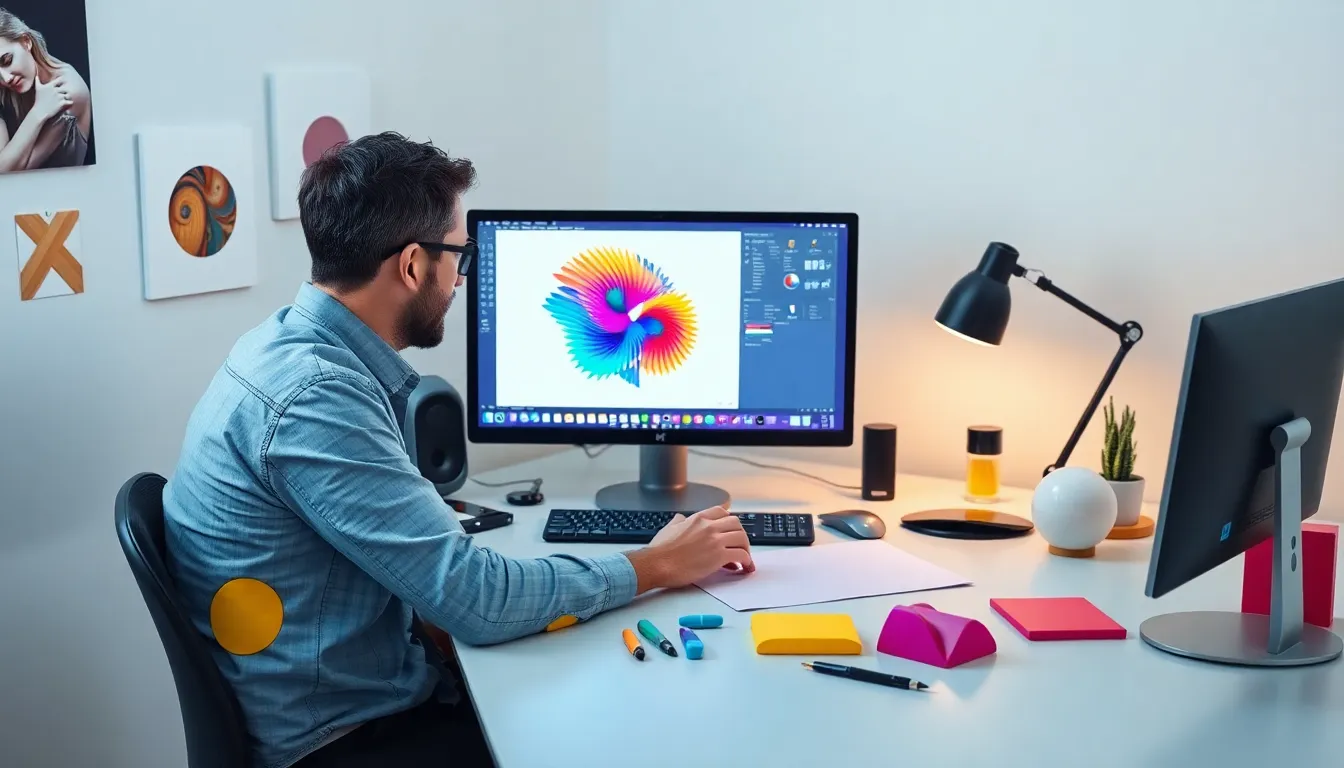Skewing objects in Illustrator can feel like magic, transforming ordinary shapes into eye-catching designs that pop off the screen. Whether you’re looking to add a playful twist to your graphics or create a professional layout, mastering the skew tool is a game changer. Imagine your rectangles strutting their stuff with a newfound flair—talk about a glow-up!
Table of Contents
ToggleHow To Skew An Object In Illustrator
Skewing shifts an object’s perspective, altering its shape and creating a dynamic appearance. This technique is highly effective for adding depth to designs. Designers can apply skewing to text, shapes, and images, enhancing visual interest in various projects.
To skew an object, users access the “Transform” feature in the menu. Selecting “Shear” opens a dialogue box with options to adjust the angle. Entering a specific degree allows for precise control over the transformation. Previewing the changes helps ensure the desired effect is achieved before finalizing.
Utilizing the bounding box provides a more intuitive method for skewing. Clicking and dragging the corner handles offers instant feedback on the manipulation. This method is particularly useful for quick adjustments during the design process.
Mastery of the skew tool empowers designers to create unique layouts and graphics. From playful logos to professional presentations, skewing adds an element of creativity. Understanding and utilizing the skew function enhances overall design skills in Illustrator.
Experimenting with various angles fosters creativity and innovation in artwork. Test different objects to explore the full range of possibilities with skewing. While some may prefer subtle adjustments, others might favor dramatic shifts. Each design choice contributes to a distinct look and feel.
Tools Required for Skewing

Skewing objects in Adobe Illustrator requires specific tools to achieve desired effects. Understanding these tools enables designers to manipulate shapes and text effectively.
Selecting the Right Object
Choosing the appropriate object is crucial for successful skewing. Designers typically start by selecting shapes, text, or images they want to modify. The Selection Tool allows users to click on the desired object directly. Once selected, visual adjustments become easier. Consider the object’s complexity too; simpler shapes skew more smoothly than intricate designs. Selecting multiple items for simultaneous skewing also enhances workflow efficiency.
Using the Right Tools
Utilizing the correct tools streamlines the skewing process. The Transform menu hosts the Shear option, crucial for precise angle modification. Entering specific values provides accurate control over the skewing effect. Additionally, the bounding box allows real-time adjustments with intuitive dragging. Designers often find the Toolbar beneficial, as it enhances quick edits. Mastering these tools results in smoother transitions and captivating designs. All tools collectively empower artists to elevate their creative projects effectively.
Step-by-Step Guide on How to Skew an Object in Illustrator
Skewing an object in Adobe Illustrator involves using specific tools to create distinct visual effects. This section outlines the process clearly for effective design.
Accessing the Transform Tool
To begin, navigate to the “Object” menu, where you’ll find the “Transform” option. Within this menu, select “Shear.” This choice opens a dialog box that offers control over the skewing process. Alternatively, clicking on the bounding box of an object provides direct access to skew capabilities. Adjusting the corner handles allows for real-time manipulation, presenting an intuitive design experience. Users can choose between precise inputs and more visual adjustments, enhancing workflow efficiency. Mastering this step leads to smoother skewing processes for various design needs.
Inputting Skew Values
Next, enter specific skew values in the dialog box provided. The vertical and horizontal shear angles allow designers to tailor the effect accurately. Positive numbers create an upward tilt, while negative values result in a downward shift. For instance, inputting a value of 30 degrees skews the object to the right. Exploring different angles helps achieve desired effects, transforming basic shapes into dynamic designs. Applying shear values enhances the visual complexity of objects, adding depth and interest to projects. Ensure adjustments align with overall design goals for optimal results.
Tips for Effective Skewing
Mastering skewing techniques enhances design aesthetics. Knowing how to adjust angles effectively maximizes impact.
Experimenting with Different Angles
Varying angles generates diverse visual effects. Positive values create a forward tilt, while negative values shift the angle backward. Experimentation reveals options from subtle slants to bold perspectives. Users can rotate shapes and text distinctly, transforming simple designs into eye-catching graphics. Consider using slight adjustments for refinement, or embrace drastic shifts for dramatic appeal. Skewing not only alters dimensions but also invites innovative compositions by presenting fresh viewpoints. A range of angles delivers unique design elements, maintaining viewer engagement and interest.
Combining Skew with Other Effects
Overlaying effects amplifies the overall design. Utilizing gradients alongside skew creates depth, enhancing dimensionality. Shadows applied with skewed shapes provide further intrigue, adding a sense of realism. Users can blend skewing with rotation for an even more dynamic approach, producing captivating and multifaceted objects. Experimenting with transparency and colors can yield striking contrasts, enriching the visual narrative. Pairing the skew tool with other Illustrator features, like effects and textures, fosters limitless creative possibilities, keeping designs fresh and engaging.
Troubleshooting Common Issues
Users may encounter some challenges while skewing objects in Adobe Illustrator. One common issue involves the object not skewing as expected. If the skewing appears distorted, ensure the object isn’t locked or grouped with other elements. Unlocking or ungrouping the object can resolve this problem.
Another frequent issue is difficulty entering specific skew values. It’s essential to check that the input fields in the “Shear” dialog box are active. Clicking directly inside the box ensures that the cursor is ready for typing.
Sometimes, users experience unexpected results when combining skewing with other effects. To avoid this, separate the skewing layer from other effects, applying them one at a time. This method helps identify which effect might be causing issues.
Applying skewing to complex shapes may result in an undesirable outcome. For best results, consider breaking down complex shapes into simpler components before skewing. Simplifying the design often leads to smoother transformations.
Issues can also arise when scaling an object after skewing. To maintain the integrity of the skewed angles, apply transformations at the appropriate steps. Skew first, then scale rather than combining both actions simultaneously.
Lastly, users might find alignment misalignments after skewing. To correct this, use the “Align” panel to realign the object within the artboard or relative to other objects. Ensuring proper alignment can significantly enhance the overall design.
By addressing these common issues, users can maximize their skewing technique, resulting in more polished and professional designs.
Conclusion
Mastering the skew tool in Adobe Illustrator unlocks a world of creative possibilities. By transforming ordinary shapes into dynamic designs, users can elevate their projects to new heights. The ability to manipulate angles and combine skewing with other effects enhances visual interest and depth.
Experimenting with different techniques can lead to unique graphics that capture attention. As designers become more familiar with the skewing process, they’ll find that even simple adjustments can make a significant impact. Embracing this skill not only fosters creativity but also ensures designs remain engaging and innovative. With practice and exploration, anyone can harness the full potential of the skew tool to create stunning visuals.

